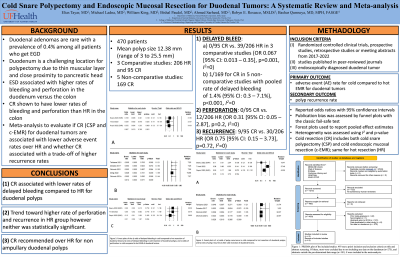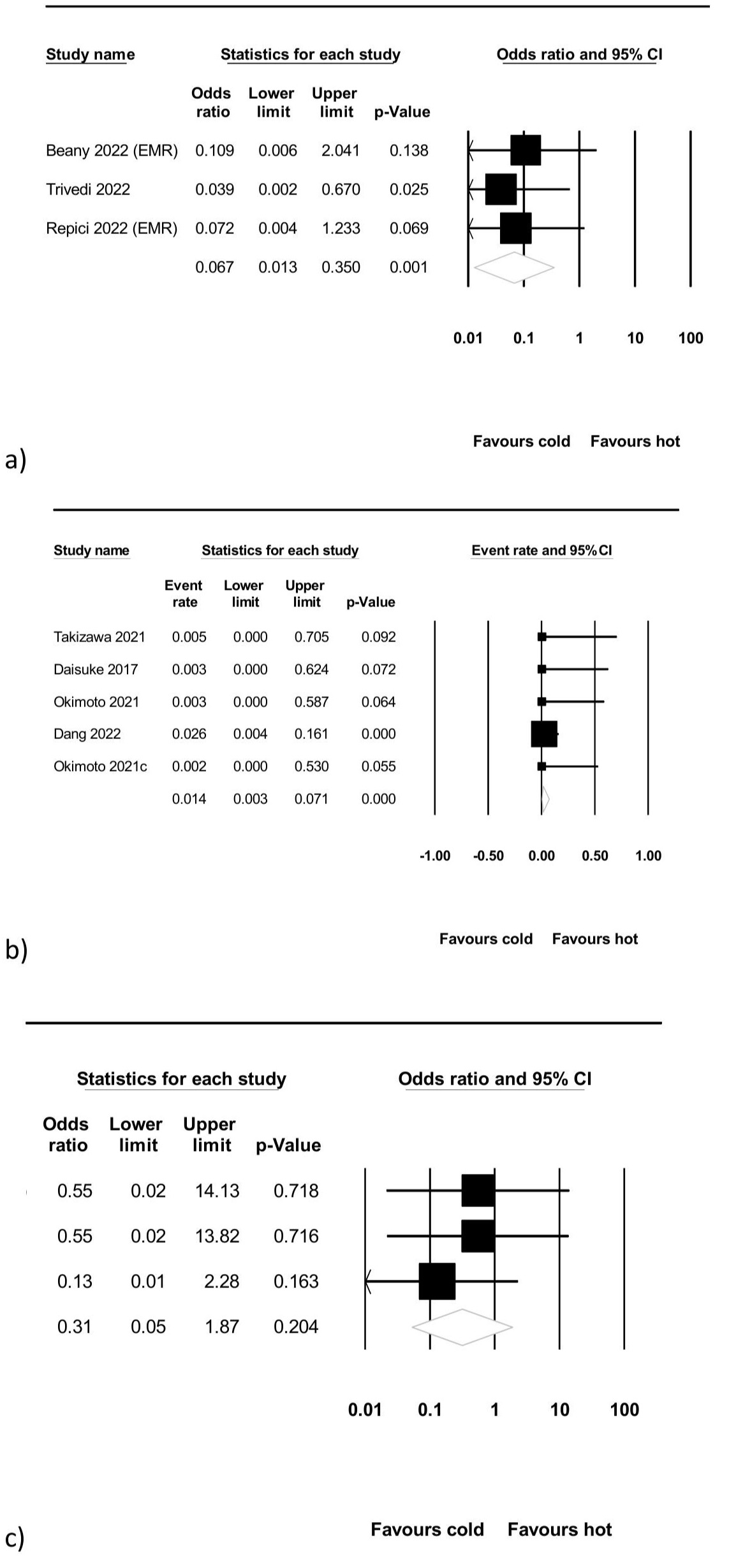Tuesday Poster Session
Category: Small Intestine
P4107 - Cold Snare Polypectomy and Endoscopic Mucosal Resection for Duodenal Tumors: A Systematic Review and Meta-Analysis
Tuesday, October 24, 2023
10:30 AM - 4:00 PM PT
Location: Exhibit Hall


Michael Ladna, MD
University of Florida
Gainesville, FL
Presenting Author(s)
Michael Ladna, MD, William King, MD, Bashar Qumseya, MD, MPH
University of Florida, Gainesville, FL
Introduction: The duodenum is one of the most challenging part in the gastrointestinal tract when it comes to endoscopic resection of premalignant polyps. Traditional endoscopic mucosal resection often involves the use of electrocautery through a hot snare (hot-EMR). However, delayed bleeding and perforation are serious adverse events of hot-EMR. Cold snare EMR (cold-EMR) has gained popularity in recent years as a safer method for endoscopic resection. We aimed to conduct a systematic review and meta-analysis to assess the safety of cold-EMR compared to hot-EMR for resection of large duodenal polyps.
Methods: We searched MEDLINE (Ovid), Web of Science, Embase, Cochrane Library and CENTRAL, and World Health Organization International Clinical Trials Registry Platform (WHO ICTRP) from inception to September 19,2022. The primary outcomes of interest were adverse events post-cold-EMR compared to hot-EMR of duodenal lesions including: delayed bleeding, perforation, and recurrence. The primary effect estimate was the odds ratio (OR) of adverse events in cold compared to hot-EMR (for comparative studies). As secondary outcomes, we reported adverse events among non-comparative study of cold-EMR and cold snare polypectomy). Outcomes were reported on forest plots. I2 was used to measure heterogeneity.
Results: 3 comparative studies assessed the rate of delayed bleeding in cold vs, hot-EMR. On multivariable analysis the rate of delayed bleeding was significantly lower in cold (0 of 95) compared to hot (39 of 206): OR 0.67 [0.013 – 0.35), p-0.0001, I2 =0. This was supported by evidence from 5 cohort studies (169 patients) showing no delayed bleeding, pooled rate 0.014 [0.003 – 0.071], p< 0.0001, I2=0. For the outcome of perforation, three comparative studies were included. There was no perforation in the cold-EMR group (95 patients) and 12 perforations in the hot-EMR group (206 patients). However, on pooled analysis, this was not statistically significant (OR=0.31 [0.05 – 1.87], p=0.204, I2=0. From the cohort studies of no patients had early or delayed perforation. In the same 3 studies the risk of polyp recurrence was similar in cold-EMR (9 of 95) compared to hot-EMR (30 of 206): OR =0.75 [1.5 – 3.73], p=0.724, I2=0. From cohort studies, 3 recurrences were noted for a pooled rate of 0.029 [0.01 – 0.085], p< 0.001, I2=0.
Discussion: For duodenal polyps, cold-EMR is associated with lower risk adverse events and similar recurrence rate compared hot-EMR. Endoscopist should favor cold EMR whenever possible.

Disclosures:
Michael Ladna, MD, William King, MD, Bashar Qumseya, MD, MPH. P4107 - Cold Snare Polypectomy and Endoscopic Mucosal Resection for Duodenal Tumors: A Systematic Review and Meta-Analysis, ACG 2023 Annual Scientific Meeting Abstracts. Vancouver, BC, Canada: American College of Gastroenterology.
University of Florida, Gainesville, FL
Introduction: The duodenum is one of the most challenging part in the gastrointestinal tract when it comes to endoscopic resection of premalignant polyps. Traditional endoscopic mucosal resection often involves the use of electrocautery through a hot snare (hot-EMR). However, delayed bleeding and perforation are serious adverse events of hot-EMR. Cold snare EMR (cold-EMR) has gained popularity in recent years as a safer method for endoscopic resection. We aimed to conduct a systematic review and meta-analysis to assess the safety of cold-EMR compared to hot-EMR for resection of large duodenal polyps.
Methods: We searched MEDLINE (Ovid), Web of Science, Embase, Cochrane Library and CENTRAL, and World Health Organization International Clinical Trials Registry Platform (WHO ICTRP) from inception to September 19,2022. The primary outcomes of interest were adverse events post-cold-EMR compared to hot-EMR of duodenal lesions including: delayed bleeding, perforation, and recurrence. The primary effect estimate was the odds ratio (OR) of adverse events in cold compared to hot-EMR (for comparative studies). As secondary outcomes, we reported adverse events among non-comparative study of cold-EMR and cold snare polypectomy). Outcomes were reported on forest plots. I2 was used to measure heterogeneity.
Results: 3 comparative studies assessed the rate of delayed bleeding in cold vs, hot-EMR. On multivariable analysis the rate of delayed bleeding was significantly lower in cold (0 of 95) compared to hot (39 of 206): OR 0.67 [0.013 – 0.35), p-0.0001, I2 =0. This was supported by evidence from 5 cohort studies (169 patients) showing no delayed bleeding, pooled rate 0.014 [0.003 – 0.071], p< 0.0001, I2=0. For the outcome of perforation, three comparative studies were included. There was no perforation in the cold-EMR group (95 patients) and 12 perforations in the hot-EMR group (206 patients). However, on pooled analysis, this was not statistically significant (OR=0.31 [0.05 – 1.87], p=0.204, I2=0. From the cohort studies of no patients had early or delayed perforation. In the same 3 studies the risk of polyp recurrence was similar in cold-EMR (9 of 95) compared to hot-EMR (30 of 206): OR =0.75 [1.5 – 3.73], p=0.724, I2=0. From cohort studies, 3 recurrences were noted for a pooled rate of 0.029 [0.01 – 0.085], p< 0.001, I2=0.
Discussion: For duodenal polyps, cold-EMR is associated with lower risk adverse events and similar recurrence rate compared hot-EMR. Endoscopist should favor cold EMR whenever possible.

Figure: Figure 1: a) risk of delayed bleeding in cold compared to hot-EMR of duodenal lesions; b) rates of delayed bleeding in cold EMR of colon polyps; and c) risk of perforation in cold compared to hot EMR of duodenal lesions
Disclosures:
Michael Ladna indicated no relevant financial relationships.
William King indicated no relevant financial relationships.
Bashar Qumseya: Assertio Management – Consultant. Castle Biosciences – Speakers Bureau. Medtronic – Consultant.
Michael Ladna, MD, William King, MD, Bashar Qumseya, MD, MPH. P4107 - Cold Snare Polypectomy and Endoscopic Mucosal Resection for Duodenal Tumors: A Systematic Review and Meta-Analysis, ACG 2023 Annual Scientific Meeting Abstracts. Vancouver, BC, Canada: American College of Gastroenterology.
